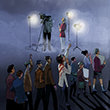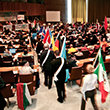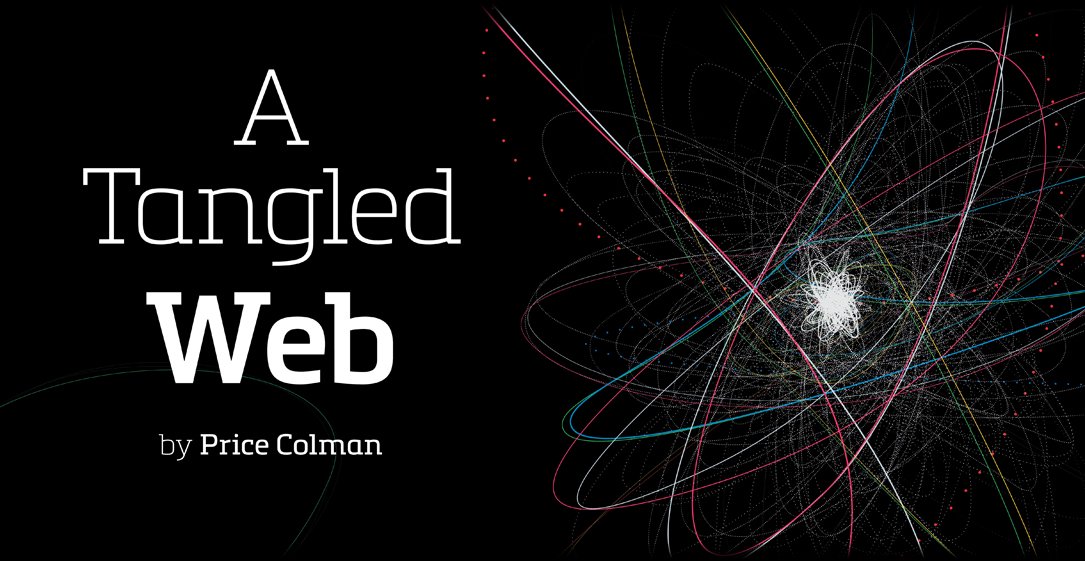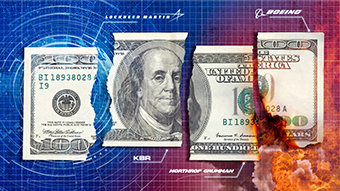The concept of an “Open Internet”—known as Net Neutrality—attempts to classify broadband services as a regulated “public” utility, like those that deliver electricity or water. But the Net is a different sort of common carrier, and while the public’s interest is important, Internet users can’t ignore the billions of dollars in private investment that made the Internet possible. The builders generally oppose regulation in favor of competition. But what is fair to both sides? Should affluent Internet users be ushered onto the fast lanes while others are relegated to crowded, often stalled slow lanes? Freedom Magazine explores those and other issues in an attempt to help readers understand what “Net Neutrality” means for everyone involved.
On a cold, snowy day in late February, as demonstrators chanted and waved signs outside, the hearing room of the U.S. Federal Communications Commission in Washington, D.C., filled with people sensing history about to be made.
They were waiting on the outcome of a vote over a somewhat obscure concept called Net Neutrality—the idea that the Internet, an ever more important communications tool on which the public depends—will remain open to everyone, equally.
Before the commission were tough, new rules, largely opposed by major players in the cable industry and other service providers who say they fear the rules will dry up future investment. When the three commissioners supporting the rules—a majority—came into the room before the vote, the crowd erupted into a spontaneous standing ovation, which echoed through the room four more times as commissioners approved the FCC’s Open Internet Order of 2015 on a 3-2 vote.
“I’ve been to a lot of FCC hearings over the years and it was a scene unlike anything I’ve ever seen at the FCC before,” said Craig Aaron, president and CEO of Free Press, an advocacy organization on the leading edge of the Net Neutrality effort.
“There were hugs on the floor of the FCC, which is not a normal thing. It was a celebration on Feb. 26.”
Not everyone was celebrating the new rules, of course.
While the order is set to take effect June 12, barring a legal stay, unresolved questions remain over whether regulation of Internet service providers will make the Internet more egalitarian or simply stifle its development by imposing new industry burdens.
Net Neutrality or Net Profits?
For more than a decade, the FCC had been bouncing back and forth between answers to the fundamental question of whose “Net” is it anyway? Does it belong to the public who use it, or to the private industry that built it? And, as such, should it be government-regulated, or not?
Even current FCC Chairman Tom Wheeler changed his tune in the space of a year. The former National Cable and Telecommunications president “evolved” from saying Internet regulation was a “non-starter” and favoring paid fast lanes, to championing what he calls “the most stringent and expansive open Internet rules in history.”
Ten years of skirmishes preceding February’s vote had drawn clear battle lines: AT&T, Verizon, Comcast and other broadband Internet access providers lined up against proponents ranging from President Obama to public interest advocacy groups such as the Electronic Frontier Foundation, Free Press, and even digital giants Amazon, Google and Netflix.
Caught in the middle were 280 million Americans with Internet connections, along with the libraries and public schools that serve them. For each of them, the Internet’s evolution into an indispensable tool for commerce, education and communications itself changed the rules of the game.
But until the FCC ruling, proponents contended they faced the very real possibility that the information superhighway might morph into a metered toll road, where the affluent could travel at any speed and those on the margins face traffic jams and closed roads.
That such scenarios might play out was suggested in 2003 when the FCC began tinkering with “guidelines” for ISPs under then-Chairman Michael Powell. Some of those ISPs, the FCC observed, tilted the playing field in their favor by pushing their own proprietary content to the head of the line.
Today, even in an era of unprecedented political polarization and divisiveness, Net Neutrality—a term coined in 2003 by Columbia University law professor Tim Wu—has inflamed passions on both sides. Its guiding principle is that all legal data on the Internet should be treated equally, and that companies controlling the infrastructure over which that data is delivered should not discriminate among data providers—or end-users.
The ability to favor proprietary content can translate into major financial gains for an ISP.
So it’s of little surprise that almost immediately in the wake of the order, deep-pocketed opponents of the new rules deployed an army of lawyers and began lobbing lawsuits—and lobbying Congress—to overturn the order.
The lawsuits claim the FCC used outmoded provisions in the Communications Act of 1934 to impose Net Neutrality. At their foundation, the suits contend the order will smother innovation and investment in the Internet, the very things responsible for its build-out.
In the order, Net Neutrality translates into three key “bright line” rules:
Rule 1: No blocking of lawful traffic. In other words, an ISP is prohibited from preventing an Internet user’s access to any legal sites. The rule specifically allows ISPs to refuse transmission of unlawful traffic, including material that infringes on copyrights, or child pornography.
Rule 2: No throttling. The order defines that as “…impairing or degrading lawful Internet traffic on the basis of content, application, service, or use of a non-harmful device.”
Rule 3: No paid prioritization. That means an ISP is prohibited from establishing a fast lane for traffic from a company willing to pay to put its content on that lane.
Moreover, the order includes a so-called “transparency clause.” Ever notice a slowdown in your Internet connection? Maybe it’s just a traffic jam. Or maybe your Internet service provider is playing traffic cop, and you got shunted to the slow lane. Under Net Neutrality, ISPs are required to disclose the reason for the slowdown.
It’s worth noting that the order does not prohibit ISPs from offering different speeds of service, at a different cost. However, the terms of so-called “tiered services” must be clearly spelled out per the transparency clause.
Good, Bad and Ugly
It’s tempting to paint Net Neutrality in stark terms, a battle of good v. evil. But it’s not that simple.
Many of the companies offering broadband Internet access spent billions to build the digital superhighway. Absent their investment in increased capacity, companies such as Netflix might not be able to deliver their content effectively, and so might not exist.
Many in the tech sector are leery of government and regulatory intrusion. While they endorse the “bright line” and transparency rules, they have reservations about other aspects of the order.
“I think the order did the right thing,” said Corynne McSherry of Electronic Frontier Foundation, a longtime advocate of Net Neutrality and the protection of personal privacy on the Net.
For the EFF, Net Neutrality is “pretty fundamental,” McSherry said. “Think of all the ways in which we use the Internet—to organize, communicate, get jobs, get educated. We depend on the Internet for so many things. That means we need a fair Internet.”
But, she says, the order gives the FCC leeway to crack down on ISPs’ practices that violate the spirit of the order, but aren’t specifically addressed in the order. That worries her.
“It seems like [the FCC] has given itself a bigger window for overregulation. The signal to us is that we have to pressure the FCC to do the right thing.”
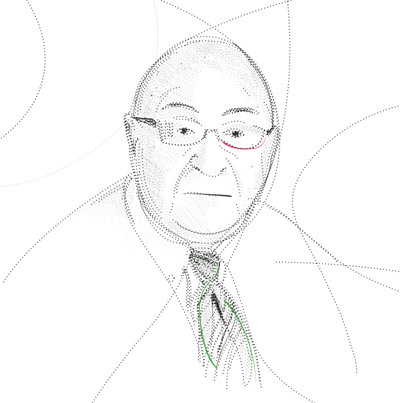
Before David J. Farber was chief technologist at the FCC from 2000-01, he was, literally, one of the people who laid the groundwork for today’s Internet. If Vinton Cerf and Robert Kahn are considered fathers of the Internet, then Farber is the grandfather. He’s also among those who think the FCC got it wrong.
“There’s been a huge amount of hype, basically predicting the end of mankind, if nothing was done,” Farber says. “There’s no sign there’s much truth to that. The FCC has totally adequate tools. They didn’t need pronouncements from on high to do that.”
Farber has a uniquely deep and informed perspective. After an 11-year career at Bell Labs, where he designed the first electronic switching system and created the SNOBOL programming language, he went on to the University of Delaware where he was instrumental in creating the National Science Foundation Network, Computer Science Network, and National Research and Education Network, precursors to today’s public Internet. He is currently Distinguished Career Professor of Computer Science and Public Policy in the School of Computer Science at Carnegie Mellon University.
He considers the 2015 order a classic case of FCC overreach.
A key component in the order is the reclassification of broadband as a telecommunications service, in effect, a common carrier under Title II of the Communications Act of 1934.
Under Title II, the FCC has much broader power to regulate.
As a consequence of a key 2014 appellate court ruling in Verizon v. FCC, the FCC was forced to change strategies on Internet regulation. Previously, the commission had classified broadband Internet access services (BIAS, in the FCC lexicon) as a telecommunications and information service. Under its own self-imposed strictures, the commission was prevented from imposing tough Net Neutrality rules on an information service.
“The headache is Title II comes with a huge amount of baggage,” Farber said. “There’s a lot of stuff enabled by Title II the commission says it will forbear. That’s not a legal term. It doesn’t bind the FCC to anything. In two years, a new president will probably appoint a new chairman … and then the new commission can do whatever it wants. That’s a dangerous place. You may trust the current commission but have no reason to trust the following one.”
The Net Landscape
So what is the Net—information or telecommunications service?
Although the line blurs as many broadband providers also offer proprietary content, a few data points may help clear the lens:
- In 1993, shortly before Tim Berners-Lee launched the World Wide Web, the Internet accounted for only about 1 percent of two-way telecommunications globally, according to a research report published in 2011 by Science Express. By 2007, that number had risen to 97 percent;
- Landline phone service in the U.S. has declined steadily, from about 193 million in 2000 to about 135 million in 2013, according to the International Telecommunication Union, based in Geneva, Switzerland;
- Internet users in the U.S. now number nearly 280 million, or about 87 percent of the population, according to the website internetlivestats.com, defining the word “ubiquitous.”
Those statistics suggest that broadband has become the de facto telecommunications service in the U.S.
Advocates of an “Open Internet” say it’s pretty clear, then, who wins if the key provisions in Net Neutrality are eliminated or watered down. ISPs, including cable and telcos, have the most to gain, they say.
If so, who loses?
A Tale of Two Libraries
How “neutral” the Internet will be is a fundamental question for everyone.
But for some—including the disadvantaged who have a tenuous grasp on access to the Net—the question resonates.
Just as Andrew Carnegie invested heavily in public knowledge by building libraries, the nation’s libraries now find themselves invested in protecting the public’s access to online information.
Former President Clinton highlighted America’s “digital divide” in a speech at Massachusetts Institute of Technology in 1998: He warned that affluent schools and libraries would have an advantage in deploying technology and providing high-speed Internet access.
That led to the establishment of a program overseen by the FCC for funding less-affluent schools and libraries in hopes of upgrading their technology infrastructure, including broadband Internet access services and Wi-Fi.
This FCC Universal Service Fund is supported by fees levied on regulated telecommunications providers. Should Net Neutrality rules be overturned in court, it remains to be seen if libraries could continue to afford to offer bandwidth-dependent services—affecting libraries large and small.
In Mancos, Colorado, population 1,320, the public library is a case in point.
An online clinic at the library for people who can’t afford an attorney but need legal guidance has become richly popular in this rural farming and ranching community, where home Internet access is spotty at best.
Ric Morgan, a lawyer based six hours away on Colorado’s Front Range, developed the clinic. He saw its significance spelled out in a recent memorable case.
“There was a young woman with two small children who’d been beaten by her husband,” Morgan recalled. The clinic helped her find legal options that enabled her to get out of the abusive situation.
“Libraries are where people come for information,” Morgan observes. “Libraries should be the hub for people seeking information of every stripe.”
The problem: There is now a waiting list to get a seat at one of the library’s few Internet-connected computers.
Some 1,600 miles away, the Detroit Public Library is everything its modest country cousin is not. Its main library, built in early Italian Renaissance style, is enormous, ornate, decorated with murals and capped by cathedral ceilings that give the building the feel of a European church.
But like its tiny counterpart in Mancos, the massive Detroit Public Library shares a similar profile. People come for the Internet. The American Library Association notes that 97.5 percent of the country’s libraries have wireless access that is free to users.
In 2013, when the Pew Research Center’s Internet & American Life Project surveyed 2,252 Americans 16 or older on their library habits, they found that 26 percent used computers or Wi-Fi connections to do everything from research for school or jobs, to taking an online class or completing an online certification (16 percent).
The message seems clear: fair and equal access to information is important for all people, no matter where they find it.
The Demographics of Access
Tellingly, African-Americans and Hispanics are more likely than other groups to use new Internet-connected library services, according to the survey. U.S. lending libraries were birthed in the inventive mind of Benjamin Franklin. It is hard to imagine a more egalitarian institution in the U.S.
Like many others, the public libraries in Mancos and Detroit have experienced their own renaissance, thanks to the Internet. In Detroit today, people come to the library for virtually every informational need under the sun: education, entertainment, business, and self-betterment—a refuge in a city that, in many ways, has been in decline for decades.
Victor Ibegbu, head of the IT department at Detroit’s library, says Internet access at the library “…is at the core of everything we do. What we’re seeing over the years is greater demand for Internet bandwidth for the library community.”
To that end, the Detroit library recently boosted broadband speeds from 3 megabits per second to 20 mbps, thanks to the addition of a fiber-optic cable. In Mancos, a 10-gigabit fiber cable was just installed near the library. Once connected, download speeds there will be substantially faster. But neither will be as fast as the 25 mbps that FCC Chairman Tom Wheeler calls “table stakes” in broadband Internet access services.
For some library Internet users, that comes with economic considerations.
“We see people coming into the library with their laptops and setting up their businesses,” Ibegbu says. “We’ve seen a whole lot more people doing web conferencing from the library.”
As the need for more bandwidth-intensive services emerge at libraries, Ibegbu says, they may be forced to either pay more or opt out of certain services—or both. That’s where the debate over Net Neutrality hits home for public libraries.
“We are providing service to people who may or may not be able to afford service,” Ibegbu says. “We would lose everything we’re trying to achieve without Net Neutrality.”
e-Vox Populi
In the lead-up to the FCC releasing its order of February 26, 2015, millions of people on both sides of the Net Neutrality debate contacted the FCC to express their views. Not surprisingly, many of the comments came via the Internet.
Net Neutrality supporters often cite the potential for certain demographic groups to be disenfranchised or marginalized in the absence of strong open Internet rules.
Net Neutrality critics, including seven plaintiffs suing to overturn the rules, contend they will stifle innovation and investment in the Internet.
Those plaintiffs include AT&T, Alamo Broadband and CenturyLink, along with trade groups—National Cable & Telecommunications Association, American Cable Association, United States Telecom Association and CTIA-The Wireless Association (formerly known as the Cellular Telephone Industry Association).
So far, fears of negative business impact have yet to play out. Though many factors influence the stock market, an analysis by SNL.com found that stocks of key large- and small-cap publicly held communications companies actually ticked up following the FCC’s February announcement of the new rules.
Former FCC attorney Kevin Werbach rejects the notion that Net Neutrality is a business killer.
“I’ve never seen convincing evidence that Net Neutrality rules per se stifle innovation and growth,” he says. “Certainly companies figure the regulatory environment into their business decisions, but the biggest factor in network investment is competition. I assume that’s why Comcast is rolling out 2 gigabit service months after the FCC Open Internet order.“
One of the FCC’s mandates from the Telecommunications Act of 1996, however, is to encourage growth and competition in the ISP sector. Statistics tell a mixed story, but in much of the U.S., consumer choice is now limited. Cable companies dominate in the high-speed arena and where there is choice, it’s typically among high-priced services. These incumbents may be a step shy of a strict monopoly, but they have a de facto monopoly and, as the FCC order notes, companies in such a position seek to guard their turf.
The ‘Haves and Have-Nots’
Of the world’s 7 billion population and counting, less than half are tapping into the Internet, according to internetlivestats.com.
It’s higher in the U.S., where roughly 88 percent of the population is plugged into the Net. Seems reasonable, given American technological strength. What’s surprising is how far the U.S. is behind the rest of the world in Internet speed and costs, ranking 16th overall in Internet speeds, according to Akamai Technologies’ 2014 State of the Internet report.
“If we had competition, we might not have needed the FCC to come in here,” says EFF’s McSherry.
Little wonder that this phenomenon—in many ways similar to the human brain’s network of neurons and synapses—has become a focal point for public policy.
Publicly, FCC Chairman Wheeler expresses confidence that Net Neutrality will withstand legal challenges. But it may be several years before there’s a definitive answer.
A 30-year award-winning journalist, Price Colman covered technology and communications for Colorado’s Rocky Mountain News from 1989 to 1996. He was Denver bureau chief for Broadcasting and Cable magazine from 1996 to 1999 and since then has written for publications throughout the Southwest.



